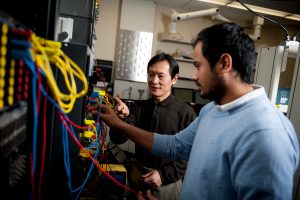
TUSCALOOSA, Ala. — Renewable energy sources such as wind-powered generators can be more reliable and efficient by better controlling the process of getting electricity onto the power grid, according to a United States patent based on research by Dr. Shuhui Li, associate professor of electrical and computer engineering at The University of Alabama.
Li, with assistance from Dr. Tim Haskew, professor and head of the electrical engineering department, found in their research that wind turbines often stop sending electricity to the grid because of competing processes in converting electricity into a form usable for power distribution. The patent, granted in November to UA, claims an algorithm that when programmed into the turbine’s power electronics better controls the electric conversion.
“There are two different control tasks that fight to control each other’s method,” Li said. “When you compete, it’s dangerous, and sometimes you compete wrong.”
The patent and two other pending patents are part of Li’s efforts to enhance energy generation from renewable resources and improve the efficiency, reliability, stability and power quality of integrated renewable and electric utility systems. For electric energy consumers, Li hopes to improve the power quality and uninterrupted energy supply to meet customers’ needs and increase incentives for energy consumers to use less expensive, more reliable energy from renewable resources and electric vehicles.
Renewable energy such as wind or solar power produce electricity at varied rates, unlike electric generators powered by the consistent burning of fossil fuels such as coal or natural gas. The wind energy produced is alternating current, or AC, electricity, which is the form of electricity used to deliver power across the grid. However, it is near impossible for a wind turbine, for example, to produce AC electricity at the correct frequency needed for distribution.
To get the AC electricity at the right frequency, the generator converts it to direct current, or DC, power that can then be converted again into AC at a frequency needed for distribution on the power grid. The problem, though, is the active and reactive power control tasks of the conversion fight with each other, messing with the other’s process, Li’s research has shown. When the fluctuation or oscillation appears in the system – as can happen with wind turbines – the generator could trip off until production ramped back up. This would interrupt the flow of electricity onto the grid, Li said.
If wind turbines and other renewable energy systems are to make up more of electricity production in the future, they need to be more reliable and with higher power quality, Li said. The technology behind the patent improves the energy coming from the wind turbine and makes it a more reliable and efficient contributor to the power grid.
The University of Alabama Office for Technology Transfer is working with Li to market the patent and related technology for commercial use. For a more detailed description, please visit UA OTT’s website.
U.S. Patent Designated No. 8,577,508 was granted Nov 5.
Contact
Adam Jones, engineering public relations, 205/348-6444, acjones12@eng.ua.edu
Source
Dr. Shuhui Li, associate professor of electrical and computer engineering, 205/348-9085, sli@eng.ua.edu